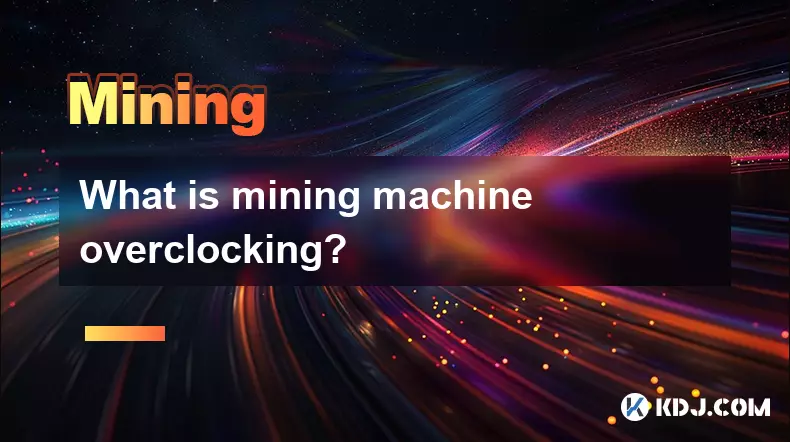-
 bitcoin
bitcoin $109523.663807 USD
-0.13% -
 ethereum
ethereum $4019.526508 USD
2.06% -
 tether
tether $1.000482 USD
0.00% -
 xrp
xrp $2.776815 USD
0.18% -
 bnb
bnb $958.942396 USD
0.12% -
 solana
solana $204.294698 USD
3.84% -
 usd-coin
usd-coin $0.999693 USD
0.00% -
 dogecoin
dogecoin $0.232115 USD
2.09% -
 tron
tron $0.338028 USD
0.84% -
 cardano
cardano $0.790920 USD
1.50% -
 hyperliquid
hyperliquid $44.871443 USD
5.60% -
 ethena-usde
ethena-usde $1.000322 USD
0.04% -
 chainlink
chainlink $21.034165 USD
2.60% -
 avalanche
avalanche $28.794831 USD
-0.54% -
 stellar
stellar $0.360466 USD
1.24%
What is the significance of the mining difficulty adjustment?
Mining difficulty adjustments maintain blockchain stability by regulating block production, ensuring network security, and influencing miner profitability across varying market conditions.
Sep 18, 2025 at 05:18 pm

Mining Difficulty and Network Stability
1. The mining difficulty adjustment ensures that block production remains consistent across the blockchain network, regardless of how much computational power is applied. When more miners join the network, hash rate increases, which could lead to faster block creation if left unchecked. The adjustment mechanism recalibrates the difficulty to maintain a target block time, such as 10 minutes for Bitcoin.
2. Without periodic difficulty changes, the blockchain would become unpredictable. Rapid block generation could flood the network with transactions, increasing the risk of orphaned blocks and chain splits. Conversely, if too few miners were active and difficulty remained high, block confirmation times would stretch out, slowing transaction finality.
3. This self-regulating feature reflects the decentralized nature of cryptocurrencies. No central authority needs to intervene; the protocol automatically responds to shifts in miner participation. It acts as a built-in stabilizer, preserving the rhythm of the blockchain even amid volatile market conditions or sudden hardware advancements.
4. Miners must constantly evaluate profitability based on current difficulty levels. A spike in difficulty reduces individual rewards unless accompanied by higher hash power. This dynamic incentivizes efficiency improvements, driving innovation in mining hardware and energy optimization strategies across the industry.
Impact on Miner Economics
1. Mining difficulty directly affects revenue potential. As difficulty rises, each unit of hash power generates fewer rewards, squeezing margins for less efficient operations. Small-scale or outdated mining setups often become unprofitable after significant upward adjustments.
2. Large mining pools adapt by upgrading equipment or relocating to regions with cheaper electricity. These economic pressures push consolidation within the mining sector, favoring well-capitalized entities capable of absorbing volatility.
3. Sudden drops in cryptocurrency prices combined with rising difficulty can trigger waves of miner capitulation, where operators shut down rigs due to negative returns. This phenomenon temporarily reduces network security until difficulty readjusts downward in subsequent cycles.
4. Profitability calculators used by miners incorporate real-time difficulty data alongside electricity costs and hardware performance metrics. Accurate forecasting helps operators decide when to power devices on or off, optimizing resource allocation across global mining farms.
Algorithmic Design Across Blockchains
1. Bitcoin adjusts its mining difficulty every 2,016 blocks, approximately every two weeks, using a simple formula comparing actual block times to expected times. If blocks were mined faster than 10 minutes on average, difficulty increases proportionally.
2. Other networks implement more responsive models. Ethereum’s now-deprecated Ethash included a “difficulty bomb” designed to discourage long-term reliance on proof-of-work. Some altcoins use continuous adjustment algorithms that react within minutes rather than days.
3. Difficulty retargeting intervals influence short-term predictability; shorter intervals reduce oscillation but may overcorrect during temporary hash rate spikes caused by mercenary mining. Networks with frequent adjustments tend to resist manipulation from transient mining surges.
4. Certain privacy-focused coins employ adaptive difficulty mechanisms sensitive to both time variance and hashrate fluctuations. These aim to prevent large mining operations from dominating block production while maintaining steady issuance rates.
Security Implications of Difficulty Shifts
1. A sharp decline in network difficulty can signal weakening security, especially if driven by mass miner exits. Lower hash rate makes the chain more vulnerable to 51% attacks, where an entity gains majority control over block validation.
2. Attackers may exploit low-difficulty periods to launch double-spending campaigns, particularly on smaller cap cryptocurrencies with limited miner participation. Exchanges often respond by increasing confirmation requirements during such windows.
3. Rapid difficulty recovery following a drop indicates strong underlying demand for mining rewards and reinforces confidence in the network's resilience. Chains that quickly rebound demonstrate robust incentive structures capable of attracting backup hash power.
4. Orphan rates typically rise during abrupt difficulty transitions. Miners experience increased stale block frequency when propagation delays interact with tight timing constraints imposed by recent adjustments.
Frequently Asked Questions
How often does Bitcoin adjust its mining difficulty?Bitcoin recalculates mining difficulty every 2,016 blocks, which occurs roughly every two weeks based on the network’s targeted 10-minute block interval.
Can mining difficulty decrease?Yes, mining difficulty can go up or down depending on the average time taken to mine the previous set of blocks. If blocks are mined slower than the target interval, the difficulty decreases in the next adjustment cycle.
What happens when no miners are active on a blockchain?If miner activity drops significantly, block production slows. Eventually, the difficulty adjustment algorithm will lower the target threshold, making it easier to mine blocks and encouraging miners to return as profitability improves.
Do all cryptocurrencies use mining difficulty adjustments?No, only proof-of-work blockchains require mining difficulty adjustments. Proof-of-stake and other consensus mechanisms do not rely on computational puzzles and therefore do not have difficulty metrics.
Disclaimer:info@kdj.com
The information provided is not trading advice. kdj.com does not assume any responsibility for any investments made based on the information provided in this article. Cryptocurrencies are highly volatile and it is highly recommended that you invest with caution after thorough research!
If you believe that the content used on this website infringes your copyright, please contact us immediately (info@kdj.com) and we will delete it promptly.
- Token Costs, AI Scaling, and Computing Power: The Quest for Efficiency
- 2025-09-27 14:25:15
- Qwen3Guard: A Leap Towards Multilingual AI Safety
- 2025-09-27 14:25:15
- Rare 1p Coin Could Fetch £200,000: Are You Holding a Fortune?
- 2025-09-27 12:25:13
- MAGACOIN Finance: Buzz, Risks, and the Altcoin Stampede
- 2025-09-27 12:25:13
- Crypto Wallets & Utility Tokens: What's the Hype?
- 2025-09-27 12:30:02
- Coin Memes, Pumpfun, and ChatGPT: Navigating the Wild West of Crypto
- 2025-09-27 14:30:01
Related knowledge

The difference between staking and mining
Sep 24,2025 at 05:18am
Understanding Staking in the Cryptocurrency Ecosystem1. Staking involves holding funds in a cryptocurrency wallet to support the operations of a block...

How to participate in testnet mining?
Sep 22,2025 at 09:18am
Understanding Testnet Mining in the Crypto Ecosystem1. Testnet mining is a method used by blockchain developers to simulate real-world conditions on a...

How to dispose of abandoned mining machines?
Sep 19,2025 at 08:19pm
Assessing the Condition of Abandoned Mining Rigs1. Begin by inspecting each mining machine for visible damage, corrosion, or missing components. Machi...

How to identify high-quality mining pools?
Sep 21,2025 at 03:19pm
Reputation and Track Record1. A mining pool’s reputation is built over time through consistent performance and transparency. Pools that have operated ...

Advantages of decentralized mining pools
Sep 20,2025 at 04:36pm
Enhanced Security and Resistance to Censorship1. Decentralized mining pools operate on blockchain-based smart contracts, eliminating the need for a ce...

What is mining machine overclocking?
Sep 21,2025 at 07:19pm
Understanding Mining Machine Overclocking1. Mining machine overclocking refers to the process of increasing the operating frequency of a cryptocurrenc...

The difference between staking and mining
Sep 24,2025 at 05:18am
Understanding Staking in the Cryptocurrency Ecosystem1. Staking involves holding funds in a cryptocurrency wallet to support the operations of a block...

How to participate in testnet mining?
Sep 22,2025 at 09:18am
Understanding Testnet Mining in the Crypto Ecosystem1. Testnet mining is a method used by blockchain developers to simulate real-world conditions on a...

How to dispose of abandoned mining machines?
Sep 19,2025 at 08:19pm
Assessing the Condition of Abandoned Mining Rigs1. Begin by inspecting each mining machine for visible damage, corrosion, or missing components. Machi...

How to identify high-quality mining pools?
Sep 21,2025 at 03:19pm
Reputation and Track Record1. A mining pool’s reputation is built over time through consistent performance and transparency. Pools that have operated ...

Advantages of decentralized mining pools
Sep 20,2025 at 04:36pm
Enhanced Security and Resistance to Censorship1. Decentralized mining pools operate on blockchain-based smart contracts, eliminating the need for a ce...

What is mining machine overclocking?
Sep 21,2025 at 07:19pm
Understanding Mining Machine Overclocking1. Mining machine overclocking refers to the process of increasing the operating frequency of a cryptocurrenc...
See all articles










































































